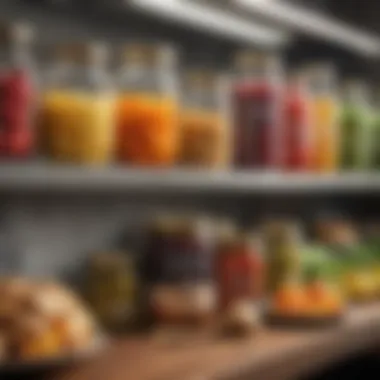Exploring the Longevity of Food: 30-Year Shelf Life Insights


Intro
In a world that values fresh ingredients and culinary trends, the notion of food with a shelf life of thirty years may seem like a strange idea. However, there are countless reasons behind the appeal of long-lasting foods, from their utility in emergency situations to their convenience for those who lead busy lives. What if one could stock a pantry with items that not only stand the test of time but also remain safe and nutritious?
This exploration into the longevity of food delves into various aspects of thirty-year shelf life foods. We’ll look at how these foods are produced, what preservation methods are employed, and how best to store these items to ensure they retain their quality.
As we unfold this narrative, it’s essential to understand the science behind why certain foods can last decades. This isn’t just about practicality; it’s also a matter of making informed culinary choices. Whether you're an avid prepper, a busy professional, or someone who simply appreciates the value of convenience, the information provided here is poised to enlighten and guide.
By examining the interplay between food, preservation, and usage in our lives, we can uncover a wealth of knowledge that will benefit both seasoned cooks and those new to the kitchen. The beauty of thirty-year shelf life foods lies not only in their longevity but also in their potential for everyday use.
Foreword to 30-Year Shelf Life Foods
The topic of long-lasting food, particularly with a shelf life extending three decades, opens a window into both practicality and nostalgia. The notion of having emergency food supplies that require little attention yet promise nourishment when needed intrigues many. As life continues to throw curveballs, understanding these foods can offer a sense of security and readiness.
Defining Shelf Life
Shelf life refers to the length of time that food products can be stored without becoming unsuitable for consumption. Various factors influence this duration, including the type of food, preservation methods, and storage conditions. For foods that offer a remarkable thirty-year shelf life, understanding their definition plays a crucial role. These are not just your average pantry staples; they are designed specifically with longevity in mind.
- Microbial factors such as the presence of bacteria and molds can shorten the shelf life significantly.
- Environmental elements like humidity and temperature fluctuations also affect food preservation.
Essentially, the shelf life of foods is determined not merely by their initial quality but by the conditions under which they are kept over time.
Historical Context of Long-Lasting Foods
The art of preserving food has roots stretching back centuries. Early methods, such as salting meats or drying fruits, were born out of necessity during times of scarcity. Civilizations from the ancient Egyptians to more recent settlers in America relied on long-lasting foods not only for sustenance but also as a means of trade.
Historically, the ability to store and preserve food has been a pivotal survival skill, affecting migration patterns and trade routes.
Over time, advancements in technology have allowed for enhanced preservation techniques, leading to the development of freeze-drying and canning. Today, understanding the historical context of these foods provides insight into modern practices and their evolving nature.
Fast forward to the present day, and the modern consumer might find solace in knowing that the meals they prepare can last significantly longer than traditional grocery fare. For those inclined towards preparedness—whether for natural disasters or simply to curb food waste—grasping the history and principles behind long-lasting foods becomes invaluable.
Chemical and Biological Principles of Food Preservation
Understanding the chemical and biological principles behind food preservation is vital when we look into 30-year shelf life foods. This knowledge explains why certain foods can withstand the test of time while retaining quality, flavor, and nutritional value. The methods of preservation employed are not merely practical steps; they show a fascinating interplay between science and food technology.
Why is this even important? Well, in consumer choices, food longevity plays a significant role. For instance, if you're stocking up for emergencies, knowing how food preservatives work could inform your decisions. It’s like having a cheat sheet for what to buy. Let's explore the elements and benefits of food preservation further, focusing on microbial growth and oxidative reactions.
Microbial Growth and Its Impact
Microbial growth is the unseen villain when it comes to food spoilage. Bacteria, yeasts, and molds are persistent foes, ready to wreak havoc on any perishable item. When discussing extended shelf life foods, it’s crucial to focus on how these microorganisms proliferate and the conditions that promote their growth.
When it comes to preserving food, it’s a game of resources. Microbes need warmth, moisture, and nutrients to thrive—remove one of these elements, and their growth can be significantly halted. That's where techniques like canning and dehydrating come into play. For example, in canning, the food is heated to kill off existing microbes and is sealed to prevent new ones from getting in.
"To ensure longevity, control the environment where food lives. Result? Freshness runs the show longer than you'd think."
Some key points to consider about microbial growth:
- Temperature: Foods stored at refrigeration temperatures inhibit microbial growth. Conversely, warm areas are breeding grounds for spoilage.
- Moisture control: Keeping moisture levels low can slow down microbial activity, especially in items such as grains and legumes.
- Sterilization methods: Techniques vary from pasteurization to irradiation, each designed to combat microbes but tailored toward the specific food type.
Oxidative Reactions in Food
Oxidation happens when oxygen reacts with components in food, leading to changes in taste, color, and aroma. It’s not just some technical jargon—this is a real concern for anyone looking to enjoy long-lasting food. In products that boast a 30-year shelf life, minimizing oxidative reactions is a priority.
Just think about it: you bite into a can of expired peaches. What was once sweet now tastes like cardboard. Freshness lost to oxidation! This phenomenon is particularly evident in fats and oils, which can develop rancidity over time.
There are practical ways to curb oxidation, such as:
- Vacuum sealing: Removing air from packaging prevents oxygen from promoting oxidization.
- Using antioxidants: Certain preservatives can be added to inhibit oxidative reactions. This is particularly common in dried fruits and canned goods.
- Storing in cool places: A cooler environment slows down chemical reactions, keeping fat integrity intact longer.
Types of Foods That Offer Extended Shelf Life
Understanding the types of foods that can provide a long shelf life is essential, especially in today’s world where both environmental factors and convenience play crucial roles in our eating habits. Foods that can be stored for long periods not only help reduce waste but can also come in handy in emergencies or when unexpected events occur. Plus, incorporating these foods into your daily meals ensures you always have something nutritious on hand without worrying about spoilage. Let’s explore a few categories of extended shelf life foods that stand the test of time.
Canned Foods
Canned foods are perhaps the champions of food preservation. The process of canning involves sealing food in airtight containers, which prevents air and bacteria from spoiling it. Think of it as a sealed time capsule of flavor and nutrition. Beans, vegetables, and fruits can be preserved this way, and the nutritional value can remain intact for decades.


- Benefits:
- Long Storage: These can last anywhere from 2 to 5 years, and in some cases far longer without any freeze or refrigerate.
- Ease of Use: Simply pop the can open, and they’re ready to eat or heat.
- Nutritional Retention: The canning process locks in nutrients, making them just as valuable as their fresh counterparts.
- Variety: You can find an impressive array of options—from savory stews to sweet fruits.
However, one might think twice before consuming canned foods regularly due to higher sodium contents, especially in savory varieties. Opting for low-sodium selections can help strike a balance between health and convenience.
Dehydrated and Freeze-Dried Foods
Next on our list are dehydrated and freeze-dried foods. Both of these methods work on the principle of removing moisture, which slows down the growth of microorganisms. In the case of freeze-drying, a process that preserves food at low temperatures produces foods that are lightweight, nutrient-dense, and can retain flavor remarkably well.
- Benefits:
- Lightweight and Space-Efficient: Perfect for hiking and camping. You pack a great amount of nutrition into a small volume.
- Versatility: Can be added to soups, oatmeal, or rehydrated and enjoyed as is.
- Flavor Retention: Many of these foods maintain a large portion of their original flavors and can taste surprisingly fresh.
Many backpackers swear by these kinds of foods, and they are not just reserved for outdoor enthusiasts; they can enhance everyday cooking, adding an interesting twist to your meals.
Preserved Grains and Legumes
Lastly, we have preserved grains and legumes, which include rice, quinoa, lentils, and beans. When stored properly, these foods can last for decades. They offer a fantastic source of protein, fiber, and essential nutrients, and they’re naturally low in fat.
- Benefits:
- Nutritional Powerhouses: Packed with protein and fiber, they help keep you full and energized.
- Adaptable: Can be cooked in a multitude of ways, allowing for a variety of dishes.
- Cost-Effective: Buying in bulk can save money, and their long shelf life means less frequent shopping.
However, it’s important to store them in airtight containers, preferably in cool, dark places, to maximize their lifespan.
Choosing the right type of long-lasting food can play a significant role in not only our emergency preparedness but also in our everyday culinary experiences. While they may not be fresh, their benefits and versatility can still pack a punch on our plates, making them worthy of a space in every pantry.
Storage Conditions for Maximizing Longevity
When it comes to ensuring food can withstand the test of time, the importance of proper storage conditions cannot be overstated. Every food item, especially those purported to have a shelf life extending thirty years, demands meticulous attention to its environment. Temperature, humidity, and an overall controlled atmosphere are pivotal to preserving the essential qualities of such foods.
Not only do these conditions impact the texture and taste, but they also play a critical role in preventing spoilage. Storing long-lasting foods with intention enhances their viability for years down the line, making them reliable options for both everyday cooking and emergency preparedness.
Optimal Temperature and Humidity Control
Temperature control is one of those golden rules folks seem to forget when it comes to food longevity. Ideally, foods should be stored in a cool, dark place, with a temperature hovering around the 65 to 70 degrees Fahrenheit mark. It’s like putting your food on a permanent vacation — a relaxed environment keeps degradation at bay.
Humidity, on the other hand, needs to be monitored closely. Excess moisture can lead to mold or spoilage, while too little can dry food out. A relative humidity level between 15 to 60 percent is often suggested to strike the right balance. Using hygrometers can be helpful to keep an eye on this. Here are some tips:
- Keep it dark: Light can accelerate degradation. Use opaque containers or store in less illuminated spaces.
- Avoid temperature fluctuations: Frequently opening storage areas can lead to changes in temperature. Try to minimize that.
- Seal it tight: Ensure that moisture cannot seep in — think of it as wrapping up a birthday gift that you plan to open only years later.
Packaging Techniques to Retain Quality
Once the right environmental conditions are correct, the next step is proper packaging. Without effective packaging techniques, even the best-designed storage conditions may lead to disappointing results. Here are some common methods to keep long-lasting foods intact:
- Vacuum Sealing: This is like putting your food in a protective bubble. By removing air, you reduce the chances of oxidation and spoilage. It’s ideal for dried foods or anything sensitive to oxygen.
- Mylar Bags with Oxygen Absorbers: Mylar bags create a barrier against light and moisture. Coupling them with oxygen absorbers can significantly prolong shelf life, as they eliminate oxygen which can lead to spoilage.
- Glass Jars: While they might not seem as convenient, glass jars are excellent for preserving food without compromising it. They don’t transfer chemicals and are airtight if sealed correctly.
- Reliable Tins or Cans: For pre-packaged options, look for cans that are dent-free and stored upright. This prevents rust and ensures nothing leaks out.
"Know your enemy, and you’ll know how to keep it from spoiling."
Use these strategies to make the most out of 30-year shelf life foods, elevating your food preservation game to the next level. The right packaging combined with optimal conditions creates a formidable defense against time.
The Role of Packaging in Food Preservation
When discussing the longevity of food, packaging steps to the forefront as a crucial factor for preserving edibility over extended periods. Proper packaging not only defends against spoilage but also plays a pivotal role in retaining the integrity of food. This part delves into how different methods of packaging fortify the survival of foods boasting a 30-year shelf life. The importance of choosing the right packaging goes beyond mere aesthetics; it can dramatically influence texture, flavor, and nutritional quality.
Vacuum Sealing Methods
Vacuum sealing stands as one of the most effective techniques for prolonging food's lifespan. By removing air from the packaging, this method creates a near-absolute barrier against aerobic bacteria and mold, which thrive in oxygen-rich environments. The principle is simple yet powerful: less air means lower chances of oxidation, leading to less spoilage.
- Benefits of Vacuum Sealing:
- Reduces spoilage significantly, allowing food to last years longer than traditional methods.
- Preserves flavor and texture, meaning your food can taste fresh even after decades.
- Saves space, as vacuum-sealed packages can be stacked neatly.
While vacuum sealing is immensely effective, success hinges on the implementation of high-quality equipment and proper techniques. For instance, if done improperly, leaks can form, which might compromise food quality.
The Use of Mylar Bags and Oxygen Absorbers
Mylar bags are a common choice for food storage among survivalists and food enthusiasts alike. These bags are made from a type of polyester that provides a high barrier to moisture and oxygen. When paired with oxygen absorbers, they elevate the preservation game significantly.


Using Mylar bags involves a few simple steps:
- Place the food in the bag and leave a little extra space at the top.
- Add oxygen absorbers, which will draw out any remaining oxygen.
- Seal the bag tightly, ensuring there are no gaps.
"The combined power of Mylar and oxygen absorbers can turn perishables into near-immortals in terms of shelf life."
Key Advantages:
- Extended shelf life, often surpassing that of vacuum-sealed items.
- Lightweight and flexible, making them easy to store.
- Resistant to punctures, which helps protect contents from contamination or spoilage due to environmental factors.
In essence, the efficacy of packaging in food preservation cannot be overstated. Whether through vacuum sealing or using high-quality Mylar bags with oxygen absorbers, these methods provide essential defenses against the enemies of food longevity — oxygen, moisture, and light. Understanding and applying such techniques can empower anyone to craft a sustainable food reserve that withstands the test of time.
Practical Applications of 30-Year Foods
The extensive shelf life of certain foods is a boon for both everyday users and those who prepare for emergencies. As we navigate through unpredictable times, understanding how to effectively include these long-lasting options in our lives becomes invaluable. The practical applications of 30-year foods help us bridge culinary creativity with preparedness, allowing consumers to reduce waste and retain quality nutrition over prolonged periods.
Utilization in Emergency Preparedness
When disaster strikes or unexpected situations arise, having a stockpile of foods that can live through the ages could mean the difference between a nourished household and empty stomachs. Imagine a storm knocking out power for days, or a sudden economic downturn affecting access to fresh food. In these circumstances, 30-year foods become a safety net.
Preparedness experts recommend at least a three-day supply of food and water per person.
- Nutrient-Rich Choices: Many long-lasting foods, such as canned vegetables or freeze-dried fruits, pack essential vitamins and minerals, maintaining a balance that is vital during challenging times.
- Storage Ease: These foods are designed not to wither over years, which means they take up less space in our homes compared to their fresh counterparts that need constant replenishing.
- Cost-Effectiveness: Stocking up on 30-year foods often costs less in the long run. Purchasing in bulk or buying during sales can save money, ensuring you are prepared without breaking the bank.
Here’s a taste of what you might include in your emergency kit:
- Canned soups and stews
- Freeze-dried fruits, like strawberries and apples
- Dehydrated beans and legumes for protein
More importantly, it’s handy to cycle through these supplies, using them in a base from your pantry. With careful planning, you can eat old supplies before they reach their ‘best use’ date. This gives your prep game a solid foundation.
"The best time to prepare is before the storm arrives, ensuring that your family isn’t left hungry in dire moments."
Incorporating Long-Lasting Foods in Everyday Cooking
Beyond emergency scenarios, incorporating 30-year foods into daily meals can infuse variety without losing nutritional value. The diversity of flavors and textures available in long-lasting options can inspire creativity in the kitchen.
Some ways to blend these unique ingredients into regular cooking include:
- Stirring Variety into Meals: Mix dehydrated vegetables into risottos or soups; they enhance not just the texture but the nutrition profile as well. Grains such as quinoa or brown rice offer a filling base.
- Experimenting with Emulsions: Combine freeze-dried herbs with oils for marinades or dressings. The potent, preserved flavors can elevate a standard salad or grilled dish to gastronomic heights.
- Make-Ahead Recipes: Incorporate long-lasting foods into meal prep. You could whip up a hearty chili with dehydrated beans, which can be stored easily. It’s simple – a one-pot meal can yield servings for days!
Cooking with these foods can turn the mundane into the extraordinary, and also, your inventive mixing and matching can be a fun experience for the whole family.
By blending long-lasting foods into our daily lives, we separate the idea of survival from mere sustenance, elevating it into a culinary adventure. Long-life foods are not just for the rainy days; they can enlighten everyday cooking, encouraging us to stretch our limits in the kitchen.
Taste and Culinary Value of Extended Shelf Life Foods
Taste is often the linchpin of culinary experiences, and it plays an essential role in determining the appeal of any food product. Extended shelf life foods, which include those designed to last decades without spoiling, often provoke skepticism regarding their flavors and overall culinary worth. This section explores these concerns, assessing the taste and quality of such ingredients, while illuminating their possibilities in the modern kitchen.
Comparing Fresh and Long-Lasting Ingredients
It's tempting to think that fresh ingredients reign supreme when it comes to flavor—after all, nothing quite beats the aroma of freshly cut herbs or the crunch of a vine-ripened tomato. However, extended shelf life foods like freeze-dried fruits or vacuum-sealed vegetables challenge this notion. While they might not flaunt the same texture or aromatic appeal as their just-harvested counterparts, they can still offer a punch of flavor that surprises many who use them.
A key factor in this comparison is the process by which these long-lasting foods are preserved. For instance, freeze-drying removes moisture while retaining a significant amount of flavor, color, and nutrients. It's a method found in several camping meals where light weight and durability are crucial. Such ingredients can affordably contribute to recipes, broadening the cooking horizons without sacrificing taste.
"We often underestimate the power of preservation techniques. Some of my best meals were from ingredients I would have dismissed at first glance."
Furthermore, the convenience of long-lasting foods cannot be overlooked. When fresh produce spoils in days, foods with a 30-year shelf life can sit in the pantry, ready to be incorporated into a dish at a moment’s notice. This ease can liberate a cook from the tyranny of schedule-bound meal preparation, making cooking more spontaneous and accessible.
Enhancing Flavors in 30-Year Shelf Life Recipes
While the ingredients might come from humble beginnings, there's a world of possibility in crafting flavorful dishes with them. Enhancing flavors in recipes that include long-lasting foods is an art and requires a bit of finesse, but it can yield remarkable results. Here are some approaches:
- Seasoning Effectively: Use fresh herbs and spices alongside long-lasting ingredients. For instance, combine freeze-dried vegetables with fresh garlic or onion for a depth of flavor that elevates the dish.
- Liquid Gold: Incorporating stock, broth, or wine can help reinvigorate the flavors within rehydrated ingredients. Simmering foods like long-lasting beans or legumes in a rich broth can maximize their taste.
- Texture Play: Pairing textures can also enhance the experience. Adding crunchy elements like nuts or croutons to a dish made primarily of softer, rehydrated ingredients can create a delightful contrast.
In summary, extended shelf life foods can hold their ground in flavor battles against fresh ingredients. With clever usage and traditional culinary wisdom blended in, these foods can be both practical and delicious. The key lies in understanding their unique attributes and seasoning them to taste, creating meals that are not only enduring in shelf life but also rich in flavor.
Economic and Environmental Considerations


Understanding the economic and environmental elements involved with long shelf life foods is vital for consumers and society at large. The rising costs of fresh produce, coupled with fluctuating food prices due to various factors such as climate change and supply chain issues, make the longevity of foods a significant concern. Investing in foods that can endure over time not only offers financial reprieve but also contributes to sustainable practices.
Cost-Effectiveness of Long Shelf Life Foods
Long shelf life foods provide an appealing avenue for cost savings. Think about it: grocery shopping can feel like a never-ending cycle of purchases, only for some items to spoil before they’re fully utilized. Foods with a 30-year shelf life can reduce the frequency of shopping trips and the overall amount spent on produce that inevitably goes bad. This is particularly relevant for families who might find themselves turning to pre-packaged meals or instant options when they run low on fresh stock.
- Bulk Buying Savings: Purchasing in bulk can lead to significant cost reductions. When buying foods designed for longevity, like freeze-dried vegetables or canned entrées, there are often deals that allow consumers to save a healthy chunk of change.
- Long-Term Usage: Having a stockpile of these foods on hand provides peace of mind. Individuals can allocate their budget more predictably, which is essential in today’s economy. Furthermore, as food prices continue to rise, long shelf life options can act like a buffer, ensuring that a family’s pantry remains well stocked without overspending.
Additionally, many long-lasting food options, such as beans and grains, yield several servings, translating to savings in both meal preparation time and costs.
Reducing Food Waste Through Preservation
Food waste is a global issue; millions of tons end up in landfills, contributing to greenhouse gas emissions and diminishing resources.
"Every bit of food that is wasted has taken resources, energy, and time to produce. The more we can preserve, the more we contribute to a sustainable planet.”
Long shelf life foods offer a practical solution to this dilemma. When meals are planned around ingredients that can last for years, the likelihood of discarding spoiled products diminishes significantly. Here’s how:
- Efficient Meal Planning: Knowing you have a stash of shelf-stable items enables better meal planning. Recipes can be crafted without the pressure of using fresh produce on a tight schedule.
- Less Spoilage Risk: Canned or freeze-dried options retain their nutritional content well past their production date. This means not only are the ingredients available when needed, but also they are safe to eat much further down the line.
In communities where food insecurity is prevalent, introducing long-lasting food solutions can lead to better food availability. Education on these options can empower families to make smarter purchasing choices, alleviate financial strain, and help in reducing the staggering statistics that surround food waste.
Challenges and Misconceptions About 30-Year Foods
Understanding the challenges and misconceptions surrounding 30-year foods is pivotal when considering their role in modern culinary practices and emergency preparedness. Despite their growing popularity, many people have lingering doubts that can prevent them from exploring these longevity options. These challenges primarily stem from a mix of cultural perceptions and genuine nutrition concerns, which we'll dissect below.
Cultural Perceptions of Long-Lasting Food
Cultural attitudes towards food significantly influence how 30-year shelf life items are received. In many societies, fresh produce and perishable items reign supreme, seen as the pinnacle of culinary experience. The notion of consuming foods that can last decades often raises eyebrows, with many equating preservation methods with subpar quality or inferior taste. This sentiment can be traced back to traditional views where fresh vegetables and meats symbolize health and vitality.
Moreover, the "out of sight, out of mind" mentality amplifies this. If something lasts a long time, it can also feel less relevant or appealing. People might instinctively think, "If it can sit there for ages, is it really any good?"
This cultural bias can pose barriers to integrating 30-year foods into everyday meals. However, we must remind ourselves that many cultures around the world have valued preserved foods in various forms—fermented items, dried fruits, and pickled vegetables, for instance. These items showcase both history and creativity in preservation techniques and demonstrate that longevity does not necessarily equal inferior quality.
Reframing the narrative around long-lasting foods could help break down these cultural barriers. Education about the preservation process and how these foods can fit into diverse culinary practices can shift attitudes. Perhaps, imagining a cozy winter stew enriched with freeze-dried herbs can soften the apprehensions and foster an appreciation for these unique ingredients.
Addressing Nutritional Concerns
Nutritional value is a crucial aspect many people grapple with when it comes to food with an extended shelf life. Questions about nutrient degradation can loom large, even overshadowing the practicality of such foods. The truth is, while some nutrient loss is inevitable during the preservation process, many long-shelf life foods retain significant nutritional integrity when stored properly.
For instance, dehydrated vegetables can still pack a punch in vitamins and minerals, especially when rehydrated before consumption. Some essential nutrients, like fiber, remain intact, making them a valuable addition to a nutritionally balanced diet. However, it’s essential to understand the nature of specific foods:
- Dehydrated Fruits: Often retain high levels of vitamins but may lose some vitamin C.
- Canned Vegetables: Sodium levels can be high, but they maintain many nutrients.
- Freeze-Dried Meals: These often retain more nutrients compared to their counterparts due to rapid freezing and vacuum sealing.
It's also vital to compare these foods against alternatives. While fresh is undoubtedly good, oftentimes, other factors such as local seasonal availability come into play. Emergency situations can also call for long-shelf life foods, where options may be limited.
In summary, incorporating an educated perspective can buttress confidence in using these items, promoting a broader acceptance and understanding of their nutritional standing. The right balance can lead to a rich culinary repertoire that values both flavor and functionality.
Epilogue: Embracing the Longevity of Food
As we wrap up our exploration of foods with a 30-year shelf life, it becomes plain to see this isn’t just about survival or emergency planning. It’s about understanding how we interact with our food in an ever-changing society. The significance of these long-lasting foods extends beyond mere convenience; it taps into deeper themes of sustainability, health, and culinary innovation.
The Future of Food Preservation Technologies
Looking ahead, the landscape of food preservation is primed for evolution. Advances in technology offer promising developments that can alter how we perceive food storage. Innovations such as smart packaging, which utilizes sensors to monitor freshness, and nanotechnology, allowing for enhanced barrier properties in packaging materials demonstrate a bright future for the preservation of food.
- Smart Packaging: These innovative technologies could notify you through your smartphone if food might be going bad, making it easier to manage what you store over decades.
- Edible Coatings: Imagine fruit with a protective, edible layer that extends its shelf life—this idea is becoming a reality, reducing reliance on plastic.
- Oxygen Scavengers: By integrating oxygen scavenging technologies inside packaging, manufacturers can significantly slow down the deterioration process of delicate foods.
As these technologies mature, they can help to improve the nutritional quality and taste of preserved foods while reducing the environmental footprint associated with food waste.
Culinary Adventures with Long-Lasting Ingredients
Embracing long-lasting ingredients is not just practical; it's an invitation to culinary creativity. Foods with extended shelf life often require a touch of ingenuity to make the most out of their unique flavors and textures.
Consider the various ways to use dehydrated beans or freeze-dried produce:
- Flavor Enhancement: Rehydrating these ingredients can unlock bold flavors. Adding spices, herbs, or marinades can transform what might seem like mundane components into gourmet meals.
- Experimentation: Different dishes can emerge from combining these ingredients in unexpected ways. Attempting a chili with dried tomatoes or a salad sprinkled with freeze-dried berries could surprise you and your guests alike.
- Cultural Inspirations: Regional specialties that utilize preserved foods—like Japanese miso or Russian kasha—can lead to culinary adventures in your very own kitchen. Exploring these traditional recipes can provide a deeper appreciation for how cultures have thrived using what nature provides, even in challenging situations.
Ultimately, the embrace of long-lasting foods aligns with sustainable eating habits, environmental conservation, and culinary delight. It encourages food lovers to think beyond the store shelf and engage in a responsible, informed, and creative approach to what they eat.
"Food is not just what we eat; it’s a reflection of who we are and the times we live in."
By understanding the myriad benefits these foods offer, we are prepared not just for future challenges but also for enhanced culinary experiences and an enriched lifestyle.















